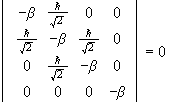

(a) Calculate the mean value <J> of the angular momentum in terms of a, b, and c.
(b) Give the expressions for <Jx2>, <Jy2>, and <Jz2> in terms of the same quantities.
(a) In the { |1>, |0>, |-1> } basis the matrices of Jx, Jy, and Jz are
 .
.
The vector |y> is represented by the column matrix
 .
.
Assume |y> is normalized and |a|2+|b|2+|c|2=1.
 .
.
Similarly,
![]() .
.
 .
.
![]() ,
,
![]() .
.
![]() .
.
Consider a system whose four-dimensional state space is spanned by a basis of common eigenvectors of J2 and Jz , { |1,1> |1,0>, |1,-1>, |0,0> } with j=0 or 1.
(a) Express the common eigenstates of J2 and Jx in terms of the eigenstates of J2 and Jz.
(b) Consider a system in the normalized state |y>=a|1,1> + b|1,0> + c|1,-1> + d|0,0>.
i) What is the probability of finding 2![]() and
and ![]() if J2 and Jz
are measured simultaneously?
if J2 and Jz
are measured simultaneously?
ii) Calculate the mean value of Jz and the probabilities of the various possible results.
iii) Answer the same questions for J2 and Jx .
iv) If Jz2 is measured, what are the possible results, their probabilities and their mean value?
(a) The basis vectors are { |1,1> |1,0>, |1,-1>, |0,0> }. In this basis the matrices for Jx, Jy,Jz,J+,J-, and J2 are
 ,
,
 .
.
To find the eigenvalues b of Jx we
require  .
.
![]() .
.
The eigenvalue b=0 is twofold degenerate.
The associated eigenvectors are
| J2 | Jx | ||
| b=0: |0,0> | 0 | 0 | |
| 2 |
0 | ||
| 2 |
|||
| 2 |
- |
(b) |y>=a|1,1> + b|1,0> + c|1,-1>
+ d|0,0> =  .
.
|a|2+|b|2+|c|2+|d|2=1.
![]()
![]() .
.
![]() as on the previous line.
as on the previous line.
![]()
![]() .
.
![]()
![]() .
.
![]() .
.
Problem:
For a simple particle moving in space, show that the wave function ψlm(r) = x2 + y2 - 2z2 represents a simultaneous eigenstate of L2 and Lz with eigenvalues l(l + 1)ħ2 and mħ. Determine l and m. Find a function with the same eigenvalue for L2 and the maximum possible eigenvalue for Lz.
Solution:
Problem:
A system has a wave function![]() .
.
![]()
![]() .
.
![]()
![]() .
.
![]() .
.
![]()
![]()
![]() for properly chosen N.
for properly chosen N.
![]() .
.
Let P(l,m) denote the probability of finding the eigenvalues l(l+1)![]() and m
and m![]() .
.
![]() .
.
The units are chosen such that ![]() =2m=1.
Find the complete set of
eigenvalues and eigenfunctions.
=2m=1.
Find the complete set of
eigenvalues and eigenfunctions.
![]() .
.
Try ![]() .
. ![]() .
.
We need ![]() .
.
![]() .
.
A particle is known to be in an eigenstate of L2 and Lz. Prove that the expectation values satisfy
![]() .
.
![]() .
.
![]() .
.
![]() .
.
![]() .
.
The only matrix elements that can be nonzero are the matrix elements of ![]() .
.
Therefore ![]() .
.
![]() .
.